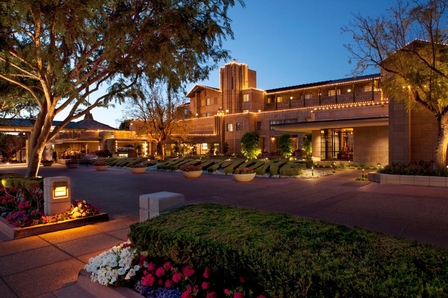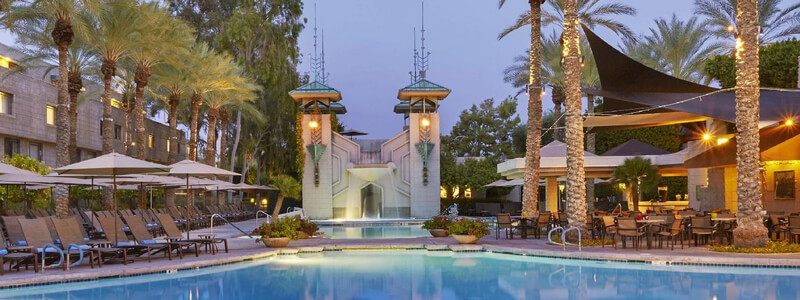The architecture of the Arizona Biltmore is just one of the beauties of this fabulous hotel.
The Arizona Biltmore truly is the “Jewel of the Desert.” It’s one hotel that truly lives up to the hype! It was built in 1929 and has been in constant use since then.

The hotel was designed by Albert Chase MacArthur, a student of Frank Lloyd Wright. In fact, MacArthur was so impressed by his teacher that he asked the famed architect to serve as a consultant on the design and construction of the Biltmore. This was a consequence, in part, of a piece of bad information. MacArthur wanted to use a method of stone construction that had been pioneered by Wright, which he assumed was patented by Wright. In fact, it wasn’t. He paid the eminent architect $10,000 as a fee for the use of this method, as well as $1,000 a month, to consult with MacArthur on the design and construction of the hotel.
1929 wasn’t a very economically sound time to open any new business aimed at wealthy guests. It was the year of the stock market crash, the beginning of the Great Depression. William Wrigley, the Chicago millionaire, came into the project and invested $1,000,000 early on and then another $1,000,000 which helped the hotel through lean times and made him the principal owner of the Biltmore, which opened in February 23, 1929. The early times were somewhat lean, but the hotel soon attracted an elite clientele. It has been a stunning success ever since its early years.
Happy Hour History Tour
The Arizona Biltmore launched a new Happy Hour History Tour on Friday nights this summer. Here’s why it’s a must for architecture buffs, cocktail lovers and fans of the Golden Age of Hollywood. Guests are invited to begin their weekend by learning about the landmark’s legendary Frank Lloyd Wright architecture and glamorous and storied past as a playground for worldly dignitaries, US Presidents, and glitterati of Old Hollywood – did someone say Marilyn Monroe?
A grand hotel
Located in Phoenix just off of 24th Street and Camelback Road, the Biltmore is one of Phoenix’s oldest resorts and has connections to Frank Lloyd Wright. In fact, Wright served as consulting architect to his student, Albert Chase MacArthur.
Over the years, the grand hotel has hosted every president from Herbert Hoover through George W. Bush plus Hollywood A-listers, members of the Rat Pack, and professional athletes. It survived Prohibition, the Great Depression and even Phoenix’s first six-alarm fire, which destroyed its fourth floor and damaged the first through third floors.
Needless to say, the Biltmore has a storied past. To share its tales, the resort has been offering 90-minute, historian led tours every Tuesday, Thursday and Saturday at 10 a.m. for some time now. These tours, complimentary for guests and $10 for non-guests, delve deep into history and architecture.
History tours
I was recently invited to take the resort’s new Happy Hour History Tour, a 45-minute version of the original History Tour. Launched this summer, the Happy Hour History Tour has been so popular it has been expanded from one to two offerings: at 5:15 and 6 p.m. Each time slot can accommodate 50 people, divided into two groups of 25.
The cost is $25 and includes sparkling wine at the beginning of the tour and a Tequila Sunrise cocktail, invented at the resort by bartender Gene Sulit, at the end of the tour. Children five and over and young adults not yet 21 can tour for $12 and get two virgin drinks. Since the tours sell out, you’ll want to make reservations to secure your spot.
We were scheduled for the 6 p.m. tour. After checking in with the concierge, we gathered nearby where two staff members passed out glasses of an Argentinean sparkling wine. A few minutes after 6 p.m., the first historian divided us into two groups. We left in the second group.
Early beginnings
Our guide, Robert E. Claire, directed us to a display of pictures to the left of the Wright-designed stained glass at the front of the lobby. There, he began with the story of Warren MacArthur who left Chicago in 1910 and his brother Charles who followed him to Phoenix two years later. The two opened a Dodge dealership, then another. Soon, they had 11 dealerships.
Seeing a business opportunity, the brothers decided to build a destination hotel. But, to do so, they needed three things: land, financing and an architectural plan. Land was easy to find. They purchased 1,300 acres eight miles from downtown Phoenix for 24 cents an acre ($312).
While they had to turn to fellow Chicagoan, chewing gum magnate William Wrigley, Jr., for financing, the brothers lucked out when it came to the architectural plan. Their brother, Albert Chase MacArthur, was an architect who had studied under Wright.
The Wright connection
Our guide explained Albert brought Wright in as a consultant for two reasons. First, he feared the project was more than he could handle, and second, Wright told him he had a patent on the pre-cast textile blocks Albert wanted to use to construct the hotel. When he learned Wright had lied (there was no patent), the famous architect was asked to leave the project.
But, Wright’s influence is felt throughout the resort. In addition to the “Biltmore Blocks” decorated with patterns inspired by palm trees, the architect designed the sprites to the left of the resort’s entrance. The sprites were thought lost when Midway Gardens, the project they were designed for, was demolished. Somehow, they later turned up in a farmer’s field.
The sprites made their way to Wright’s widow, who had six casts made. She gifted these casts to the Biltmore in 1985 just as she had previously gifted “Saguaro Forms and Cactus Flowers,” a stained glass artwork based on an original sketch made by the famous architect.
The Aztec and Gold rooms
We saw both the sprites and the stained glass before moving into the Aztec Room. The octagonal space is impressive with its 35,000 pound copper roof and ceiling. Standing in its center, you can see the curtains behind which the movie screen was installed and imagine parties held here by Supreme Court Justice Sandra Day O’Connor, Senator John McCain and President Ronald Regan.
Next, we headed to the Gold Room. The amount of gold leafing in the room is second only to that inside the Taj Mahal. “I think that’s where most of Mr. Wrigley’s budget went,” Claire said.
He went on to describe what dinner would have been like here in the resort’s early days. A blue curtain would have separated the Gold Room from the lobby. If you arrived after 6 p.m., the curtains would be closed, and you wouldn’t be seated. Because the resort was eight miles from downtown Phoenix and nothing else was nearby, you missed dinner.
Dinner included several courses and wine pairings. An orchestra played in what used to be the pit above the room’s entrance. Men wore formal attire, and women wore ball gowns. Wright designed the steps into the room to emphasize the gowns and make women’s entrances and exits more dramatic.
The Mystery Room
After discussing two massive wall paintings depicting Native Americans, we headed up to the second floor. Several of us took the opportunity to snap a photo of the lobby from the overlook. Claire pointed out Room 1201, a favorite of actor Clark Gable. The room is nothing special, he said, but it is close to one of Gable’s favorite resort hangouts, the Mystery Room.
We briefly stopped in the hallway lined with black and white photos to discuss one or two before continuing to the Mystery Room. During Prohibition, guests would congregate here for cigars, cigarettes, illegal booze and maybe even a game of cards. Above, a searchlight would scan the desert for cops. If any were spotted, the operator would shine the light through the room’s skylight to alert the partyers below.
For a while, the Biltmore tried to turn the Mystery Room into a speakeasy, posting a password on Twitter to use when it opened on Sunday nights. Now, when not open for tours, the Mystery Room appears to be used as office space.
The History Room and balcony
Backtracking to the staircase, we went to the third floor’s History Room next. Originally a library, it’s now filled with historical photos. Here, Claire explained that Wrigley wanted the same crowd who summered at George Vanderbilt’s mansion, Biltmore Estate, Asheville, N.C. to winter at his resort, so he chose the name Arizona Biltmore.
Further down the hall, we stepped out onto the balcony overlooking the resort’s front lawn. By now, it was dark. Lights illuminated the Wrigley Mansion perched on a hill nearby. Claire pointed out the spotlight, seldom used anymore, that would signal Mystery Room guests during Prohibition.
Selfies and the Tequila Sunrise
Nearing the end of the tour, we took the stairs back to the lobby. (An elevator is available for anyone who needs assistance.) Claire directed us to a small room off the crowded bar where live music played. We were given the opportunity to choose a celebrity, whose face was pasted on a Popsicle stick, for selfies. We found seats along the wall.
Servers brought in trays of Tequila Sunrises and passed them out. It’s a fitting end since, as I mentioned earlier, the drink was created by resort bartender, Gene Sulit. Legend has it a frequent guest asked Sulit to “surprise” him with a tequila cocktail he could sip poolside. Sulit mixed soda, tequila, Crème de Cassis and fresh lime juice. The drink is a much lighter and more refreshing version of the orange juice and maraschino cherry concoction that passes for the Tequila Sunrise today.
Dining at the Biltmore
Following the tour, most of our tour group headed to the patio to sip their drinks. We noticed participants from other tours, identifiable by the bright pink wristbands we were given for the tour, sitting at the bar. We had reservations at Frank & Albert’s and made our way there.
Tour participants receive 15 percent off their dinner at either of the Biltmore’s restaurants: the more casual Frank & Albert’s and its flagship restaurant, Wright’s at the Biltmore. Both are outstanding; it just depends on the experience you want. We chose Frank & Albert’s because we thought it would be nice to have a more relaxing dinner after the tour.
Named for the hotel’s architects, Frank Lloyd Wright and Albert Chase MacArthur, the restaurant serves wood-fired pizzas and a certified Angus cheeseburger along with more upscale options like prime ribeye steak and Baja striped sea bass. We started with the crispy duck wings. Glazed with hoisin sauce, the meaty wings were borderline too sweet (I would have liked a little more heat instead), but I’d definitely order them again.
Our meal
For dinner, I ordered the special, which our server described as a deconstructed scallop pot pie. It was amazing: three perfectly seared scallops flanked by potatoes, mushrooms and other vegetables. The white powder piled in the middle of my plate baffled me at first. It tasted like bacon and melted into the consistency of warm butter on my tongue. The bacon dust is amazing. I dipped everything in my plate on it and would go back for more.
My husband ordered the meatloaf. Formed in a tube shape then sliced, the disc was seared on all sides, rested on a bed of cheddar mashed potatoes and topped with slightly spicy chipotle ketchup and crispy onions. He loved the sear on it; I loved the chipotle ketchup. Overall, it was a tasty dish I’d recommend to a friend.
Of course, we had drinks with our meal. My husband, who had only taken a few sips of his sparkling wine and Tequila Sunrise, started with a Bourbon Block, featuring Knob Creek, walnut liqueur, pear liqueur and bitters. I helped him finish that drink when he transitioned to a boulevardier. When you consider the cocktails average $15 and a glass of sparkling wine goes for about the same, you realize what a great deal the tour is for $25.
Ending the evening
We finished with a shared bread pudding and cappuccinos. The bread pudding came in a glass jar and was not what I expected. As best as I could tell, it consisted of small bread pieces tossed in cinnamon sugar, fried, placed in the jar and topped with vanilla cream sauce. It was delicious, just not traditional bread pudding.
I can see why the Happy Hour History Tour is so popular. You learn a lot in a short period of time and get to see places in the hotel you might not realize exist. Plus, you get two drinks and a 15 percent discount on dinner. If you’re looking for something unique to do in Phoenix on a Friday night, this is it.
History of the Hotel
Originally the hotel was built at a 9-mile distance from Phoenix. The town of Phoenix has grown to encircle the hotel, from a sleepy city of less than 50,000 in the 1920s, it is now the 6th-largest city in the US, a metropolis with major professional sports teams and universities and a growing population of winter time snowbirds. Over the years the Arizona Biltmore has hosted every US President since Herbert Hoover and the elite of Hollywood: George Burns and Gracie Allen, Fred Astaire, Marlon Brando, Nicholas Cage, Tom Cruise, and Jay Leno.
Ronald Reagan spent his honeymoon with Nancy Davis at the Arizona Biltmore. Clark Gable lost his wedding ring on the golf course and was overjoyed when an employee found it for him. Marilyn Monroe had her favorite swimming pool at the resort – The Catalina Pool – where she could often be seen lounging by the water. Irving Berlin is said to have written the words for “White Christmas” while staying at the Biltmore.
Frank Lloyd Wright’s Contribution
The inspiration of Wright is everywhere in the Biltmore. The long, fine lines of his architecture are everywhere standing in sharp contrast to the designs of nature at the hotel. In fact, Wright was asked to write a letter disclaiming that he had designed the building and did. “Albert McArthur is the architect of that building – all attempts to take credit for that performance from him are gratuitous and beside the mark.”
All questions of credit aside, the building is a wonder of “modern” 20th-century architecture. The style is very green, the concrete blocks are of a unique and specific style, unique to the Arizona Biltmore. The blocks are created, cast from the soil extracted during the hotel’s construction. The style is supposed to resemble a cross-section of a felled palm tree. Others have said that is represents the solution to a mathematical equation. Whatever it may be, it is utterly unique and very beautiful.
The hotel offers many services; among them is a spa with wonderful lounges and remarkable services. I had a signature massage and floated away totally free of stress. It is a service not to be missed by the weary visitor. There is also a quite exceptional golf course, putting green and tennis courts which are available for hotel guests. Ah yes, the food is very refined and special with several signature restaurants from which to choose.
This is a hotel that truly lives up to its reputation as a jewel. It cannot be recommended too highly.
Arizona Biltmore, A Waldorf Astoria Resort
2400 E Missouri Ave
Phoenix, AZ 85016
Phone: (602) 955-6600
Reservation information can be found at www.arizonabiltmore.com

